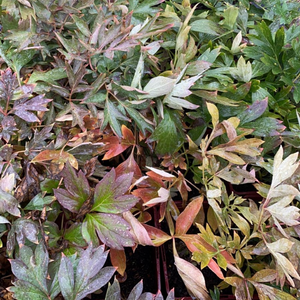Although we may feel like taking a bit of a break after a strange summer and all the Chelsea excitement, work does not stop when Autumn comes around.
Don't put those tools away just yet, there are plenty of things to be done in the garden! And not just playing the fool (although that is important too)!
Here are some suggestions of best garden practice in Autumn.
Planting
September and October are the ideal time for getting those new peonies in the ground. In short, you'll want to:
- plant them in a sunny/partly shady and sheltered spot
- make sure the soil is free draining
- plant herbaceous peonies with the crown no more than 5cm below the ground. With container grown plants, simply plant them out at the same level as they were in the pot
(Detailed instructions on planting tree, herbaceous and intersectional peonies)
Moving and Dividing
If you have a well-established peony in your garden that’s happily expanding, late October/early November is the perfect time to move and/or divide it. Contrary to popular opinion, peonies don’t mind a change of scenery. In fact they quite like it, as long as you follow a few simple guidelines:
- Cut back any dead foliage to about 2cm above the ground
- Dig up as big a clump as possible, being careful not to damage any ‘eyes’ or buds that are developing at or just below surface level
- Divide your peony with either a sharp spade or a pruning knife (depending on the size of the plant), ensuring that each piece of root that you divide has at least 3-5 ‘eyes’ or buds
- Whether you are moving or dividing your peony it is best to plant it as soon as possible after lifting it to minimise disruption to the root system - ideally planting it the same day
Like us, peonies take some time to adjust to new things, so it may happen that your peony will not flower the following year. As long as you have taken the above care in replanting it, you don’t have to worry. This is normal and it is just taking some time to settle in to its new position. It will no doubt flower in years to come.
In the meantime
Before you start launching into getting your peonies ready for their next fabulous flowering season, there is something worth taking a few moments to savour – their foliage.
The colours on peonies Autumn leaves is a feast for the eyes. You can expect to see varying shades of reds, oranges, purples, greens and browns.
It’s really such a treat and a great opportunity to take some time out from the day - best enjoyed with a fellow nature enthusiast, relaxing on the garden bench over a cup of tea.
The range of autumn colours on Herbaceous peony leaves is very wide but Intersectional peonies foliage maintain their rich hues and last considerably longer than Herbaceous peonies in autumn. And while Herbaceous leaves tend to go brown and shrivel up before dropping off, Intersectionals leaves maintain their form and prettiness right until the very end. Look at them showing off their fancy foliage (pictured right)!
And that’s one of the many reasons we love peonies – their ability to remain elegant, no matter what!










